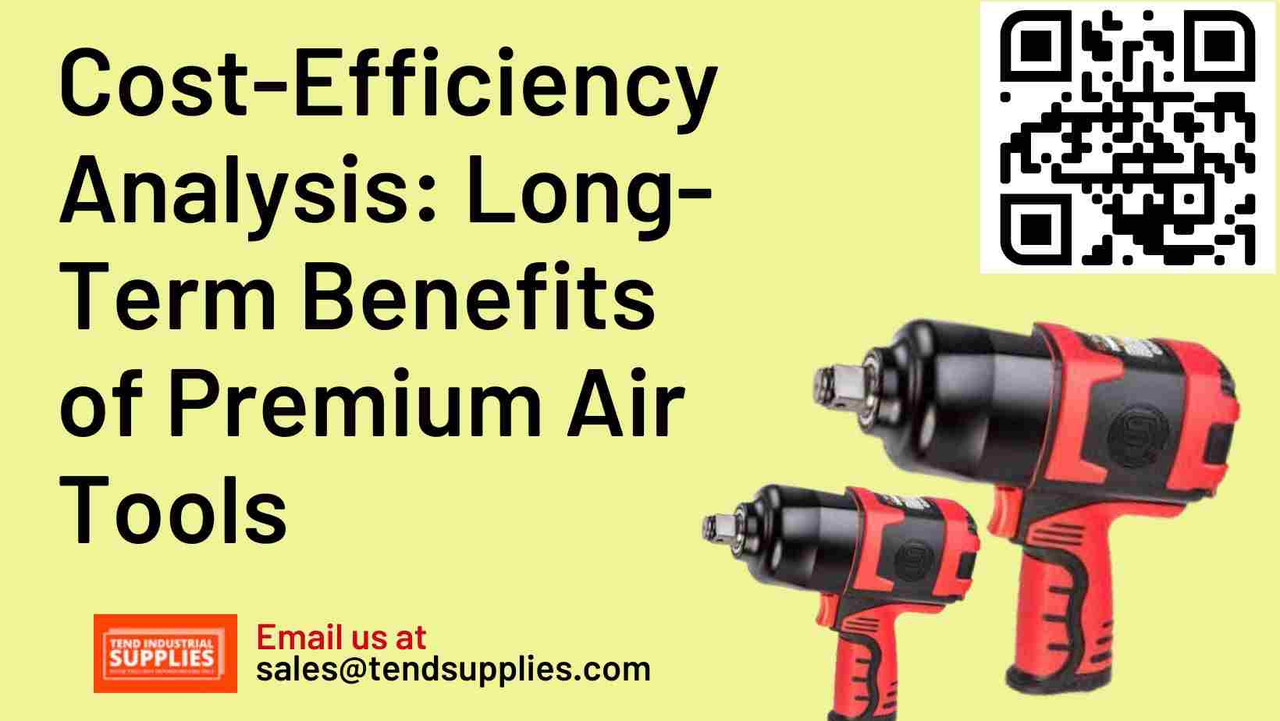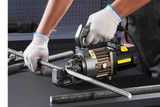Cost-Efficiency Analysis: Long-Term Benefits of Premium Air Tools
In industrial and construction work, the choice of tools can make or break a project's success. Air tools, also known as pneumatic tools, have carved out a significant niche among the myriad options available. Powered by compressed air, these tools offer unique advantages that have made them indispensable in many industries. However, when selecting air tools, the age-old question arises: is it worth investing in premium options? This comprehensive analysis delves into the long-term benefits of choosing high-quality air tools, focusing on their cost-efficiency and overall value proposition.
Key Takeaways From Article
- Premium air tools offer superior durability and longevity, reducing replacement frequency and costs.
- Improved productivity and efficiency lead to significant labor cost savings over time.
- Enhanced energy efficiency results in lower operational costs and reduced environmental impact.
- Reduced maintenance requirements and improved safety features contribute to overall cost savings.
- The compounding effect of these benefits often outweighs the higher initial investment in premium air tools.
Understanding the Air Tool Landscape
Before we dive into the cost-efficiency analysis, it's crucial to understand what sets premium air tools apart from their standard counterparts. Premium air tools are typically characterized by:
- Superior build quality
- Advanced engineering and design
- Use of high-grade materials
- Enhanced durability and longevity
- Improved performance and precision
- Better energy efficiency
- Extended warranties and after-sales support
These features contribute to a higher initial cost, often leading buyers to question whether the investment is justified. However, as we'll explore in this article, the long-term benefits of premium air tools can far outweigh their upfront costs.
Related Article: The Hidden cost of Cheap Hand tools against quality tools
The Initial Investment: A Closer Look
The initial price tag can be a significant factor when considering the purchase of air tools. Premium air tools generally have a higher price than standard or budget options. This higher cost is attributed to several factors:
- Research and Development: Premium tool manufacturers invest heavily in R&D to create innovative designs and improve existing technologies.
- Quality Materials: High-grade metals, advanced polymers, and precision components contribute to the cost.
- Manufacturing Processes: Rigorous quality control and sophisticated production techniques ensure consistent performance.
- Brand Value: Established brands with a reputation for quality often command higher prices.
While the initial investment might seem steep, it's essential to view this cost in the context of the tool's entire lifecycle. As we'll see, the true value of premium air tools becomes apparent when we consider their long-term performance and cost-efficiency.
Long-Term Cost Savings: Breaking Down the Benefits
1. Durability and Longevity
One of the most significant advantages of premium air tools is their exceptional durability. High-quality materials and superior construction techniques result in tools that can withstand the rigors of daily use in demanding industrial environments. This durability translates directly into longevity, meaning premium air tools often outlast their cheaper counterparts considerably.
For example, a standard air impact wrench might need replacement every 2-3 years in a heavy-use setting. In contrast, a premium model could easily last 5-7 years or more under the same conditions. This extended lifespan means fewer replacements, resulting in significant cost savings.
To illustrate this point, let's consider a hypothetical scenario:
- Standard air impact wrench: $200, replaced every 3 years
- Premium air impact wrench: $500, replaced every 7 years
Over 21 years:
- Standard tool cost: $1400 (7 replacements)
- Premium tool cost: $1500 (3 replacements)
While the costs appear similar, this doesn't account for the increased productivity and reduced downtime associated with the premium tool, which we'll explore next.
2. Improved Productivity and Efficiency
Premium air tools are engineered to deliver superior performance, directly impacting productivity. Features such as higher power output, better control, and enhanced precision allow workers to complete tasks more quickly and with better results. This improved efficiency can lead to significant time savings over the tool's lifetime.
Let's quantify this benefit:
Assume a task takes 10 minutes with a standard air tool and 8 minutes with a premium tool. In a typical workday where this task is performed 20 times:
- Time saved per day: 40 minutes
- Time saved per year (250 working days): 167 hours
If we value labor at $30 per hour, this translates to an annual labor cost saving of $5,010. Over the 7-year lifespan of our hypothetical premium tool, that's a potential saving of $35,070 in labor costs alone.
3. Energy Efficiency
Premium air tools often boast superior energy efficiency compared to standard models. This efficiency is achieved through advanced motor designs, optimized air consumption, and better overall engineering. The result is a tool requiring less compressed air to operate, reducing energy costs over time.
To understand the impact of energy efficiency, let's look at air consumption rates:
- Standard air tool: 5 CFM (Cubic Feet per Minute)
- Premium air tool: 4 CFM
Assuming 1000 hours of operation per year and an electricity cost of $0.12 per kWh:
- Standard tool energy cost: $360 per year
- Premium tool energy cost: $288 per year
Over a 7-year period, the premium tool could save approximately $504 in energy costs. While this may seem modest, it's important to remember that this is just for a single tool. These savings can multiply significantly in a workshop or factory setting with multiple air tools.
For a more detailed exploration of energy efficiency in pneumatic tools, check out our article onEnergy Efficiency of Pneumatic Tools: A Closer Look.
4. Reduced Maintenance and Repair Costs
Premium air tools are built to last, so they typically require less frequent maintenance and are less prone to breakdowns. This reliability translates into reduced maintenance costs and less downtime due to repairs.
Consider the following scenario:
- Standard air tool: Requires maintenance every 500 hours of operation
- Premium air tool: Requires maintenance every 1000 hours of operation
Assuming a maintenance cost of $100 per service and 1000 hours of operation per year:
- Standard tool maintenance cost: $200 per year
- Premium tool maintenance cost: $100 per year
Over a 7-year period, this results in a maintenance cost saving of $700. Moreover, the reduced frequency of maintenance means less downtime and higher overall productivity.
5. Enhanced Safety Features
While not directly related to cost, the superior safety features often found in premium air tools can lead to indirect cost savings. Improved ergonomics, better vibration control, and enhanced safety mechanisms can reduce the risk of workplace injuries. This, in turn, can lead to lower insurance premiums, reduced worker compensation claims, and fewer lost work days due to injuries.
For more insights on selecting and maintaining air tools for maximum efficiency and durability, refer to our guide on Maximizing Efficiency and Durability: A Guide to Selecting and Maintaining Air Tools.
The Compounding Effect of Quality
Considering all these factors together – durability, productivity, energy efficiency, reduced maintenance, and enhanced safety – the long-term cost benefits of premium air tools become clear. These benefits compound over time, leading to substantial savings that far outweigh the initial higher investment.
Moreover, the use of high-quality tools often results in better quality work, which can enhance a company's reputation and lead to more business opportunities. While harder to quantify, this indirect benefit can significantly impact a business's bottom line over time.
Environmental Considerations
In today's eco-conscious world, the environmental impact of our tools and operations is an important consideration. With their longer lifespan and higher energy efficiency, premium air tools contribute to reduced waste and lower carbon footprints. This aligns with sustainable business practices and can be a selling point for environmentally conscious clients.
Making the Right Choice for Your Business
While the benefits of premium air tools are clear, it's important to note that there may be better choices for some situations. Factors to consider include:
- Frequency of use
- Nature of tasks
- Budget constraints
- Specific industry requirements
Standard air tools might be sufficient for occasional or light use. However, for businesses that rely heavily on these tools or operate in demanding environments, the long-term benefits of premium air tools often justify the higher initial investment.
Ready to experience the long-term benefits of premium air tools for your business? Explore our wide range of high-quality pneumatic tools at Tend Industrial Supplies. Our experts are ready to help you find the perfect tools to maximize efficiency and minimize long-term costs. Contact us at sales@tendsupplies.com to discuss your needs and discover how premium air tools can transform your operations.
Related Articles
- Exclusive 10% Discount on Industry-Specific Shinano Air Tool Bundles: Precision and Performance for Automotive, Aerospace, Manufacturing, Woodworking, and Heavy Equipment Maintenance
- Cost Efficiency Using Shinano Premium Air Tools: General Manufacturing and Fabrication Bundle
- The Shinano Premium Air Tools Automotive Repair and Maintenance Bundle
Frequently Asked Questions (FAQs)
Q: How much more do premium air tools typically cost than standard options?
A: Premium air tools can cost 50% to 200% more than standard options, depending on the brand and specific features. However, their longer lifespan and improved performance often offset this higher initial cost.
Q: Can premium air tools make a significant difference in productivity?
A: Yes, premium air tools can substantially boost productivity. Their superior design and performance can reduce task completion times by 10-25%, which adds up to significant time savings over the tool's lifetime.
Q: Are premium air tools worth it for small businesses or DIY enthusiasts?
A: Premium options can be a wise investment for small businesses that use air tools frequently due to their durability and efficiency. For DIY enthusiasts, it depends on usage frequency and project complexity. Occasional users might find standard tools sufficient, while serious hobbyists could benefit from premium quality.
Q: How do I maintain premium air tools to ensure they last as long as possible?
A: Regular maintenance is key to maximizing the lifespan of premium air tools. This includes cleaning after each use, proper lubrication as per manufacturer guidelines, storing in a dry environment, and scheduling professional servicing at recommended intervals. Check out our guide on selecting and maintaining air tools for more detailed maintenance tips.
Q: Do premium air tools require special compressors or air systems?
A: While premium air tools don't necessarily require special compressors, they perform best with high-quality air systems. Ensuring clean, dry air and proper pressure can significantly enhance the performance and longevity of your premium tools. Consider investing in a sound air filtration system and regularly maintaining your compressor for optimal results.
For more insights on air tools, including their pros and cons, this article from TikWeld helpful:Exploring the Pros and Cons of Air Tools in Your Workshop.
To delve deeper into the durability and longevity aspects of pneumatic tools, this resource from PneumaticToolz offers valuable information:Durability and Longevity of Pneumatic Tools.








